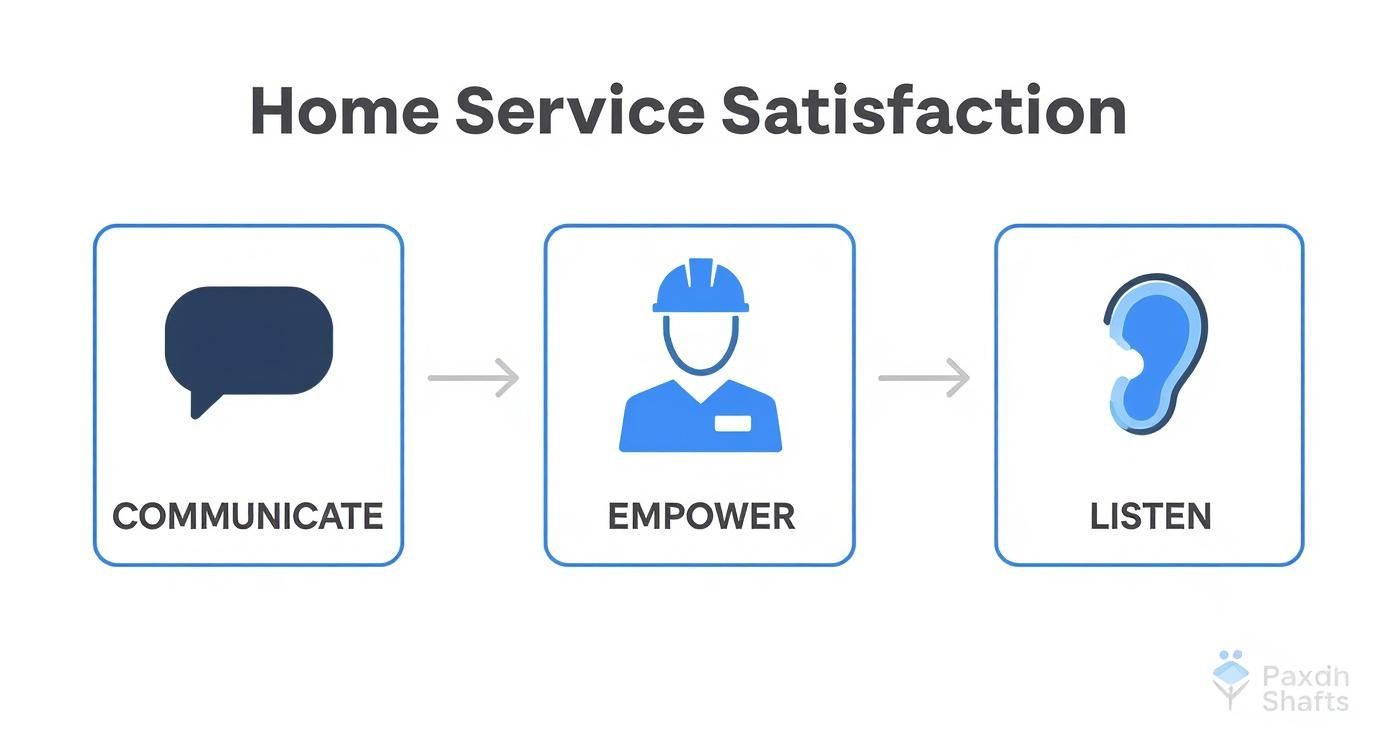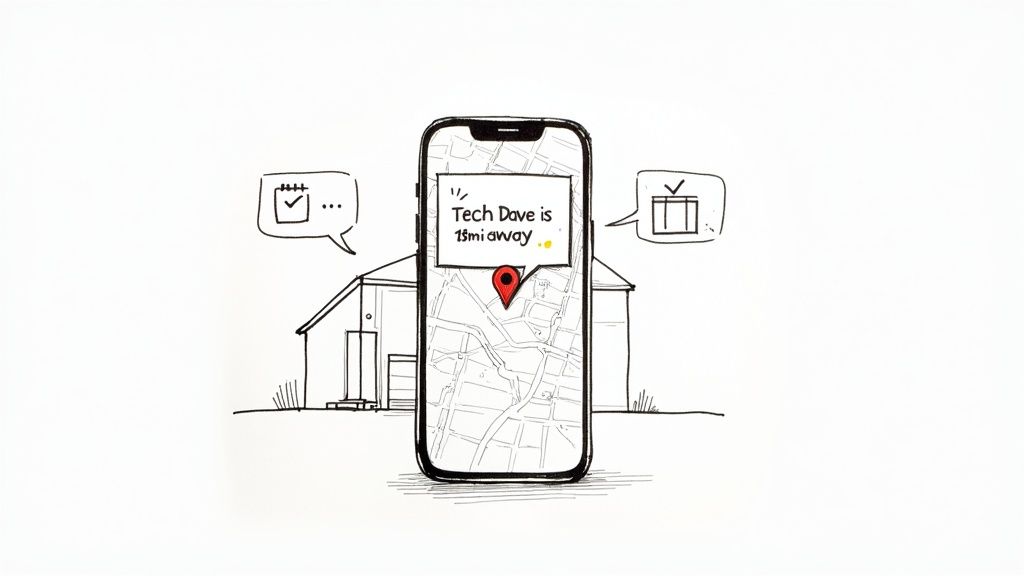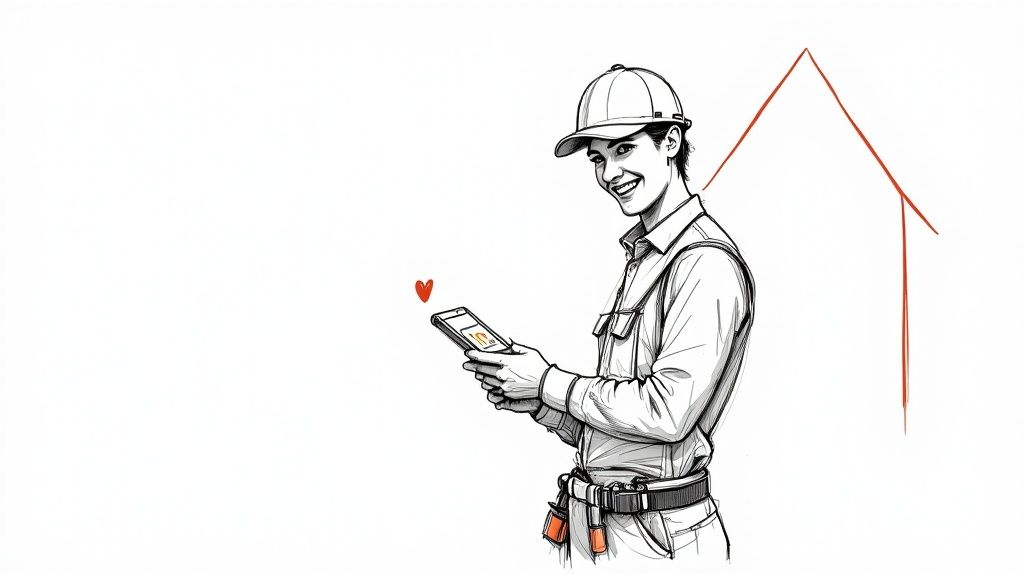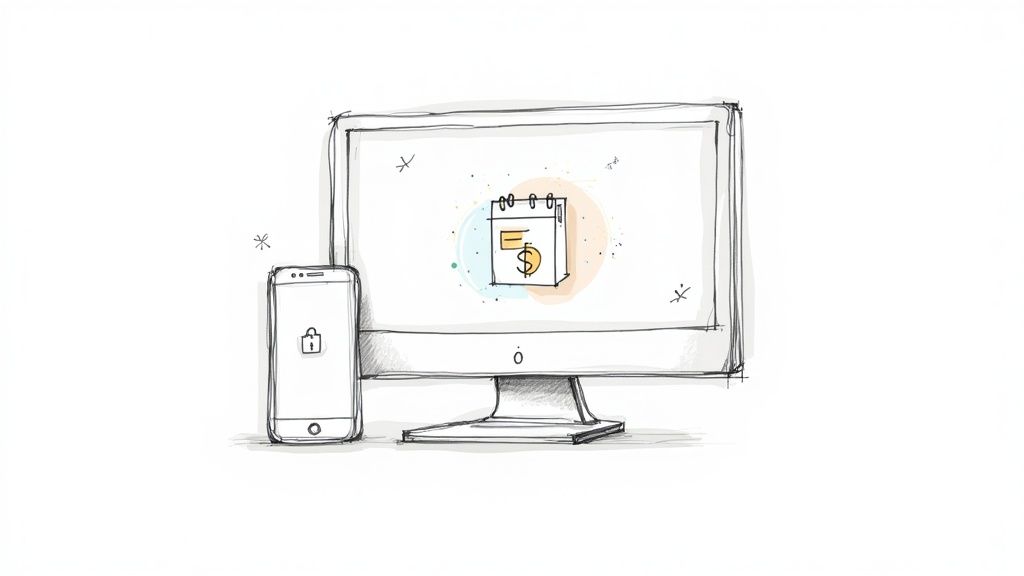Improving customer satisfaction is really about nailing every single interaction, from the moment a potential customer calls you to the follow-up after the job is done. It’s a full-circle approach that involves giving your technicians the right tools, creating smart feedback loops, and communicating proactively to build real trust with every homeowner.
Going Beyond "Good Enough" in Home Services
Let's be real—in today's crowded home service market, a customer who is just "satisfied" isn't necessarily a loyal one. The old playbook is out. The game has shifted from basic contentment to earning genuine trust. Homeowners today expect more, which means proactive communication and a seamless service experience are no longer optional—they're the starting line.
The key to truly leveling up your customer satisfaction is to look at the entire customer journey. This means mastering every touchpoint, from that first phone call to the final follow-up email, and ensuring it's a consistently positive experience.
We've found this boils down to three core components:
- Proactive Communication: Keeping customers in the loop every step of the way. This cuts down on their anxiety and builds confidence in your company.
- Technician Empowerment: Giving your team in the field the training and authority to be true customer advocates, not just repair experts.
- Effective Feedback Systems: Actively listening to what your customers are saying—the good and the bad—to celebrate what's working and fix what isn't.
Think of it as a continuous cycle, not a one-and-done checklist.

This process shows how communication, empowerment, and listening all feed into each other to create a better customer journey from start to finish.
The Satisfaction Paradox
Here’s something interesting we've noticed: just meeting expectations doesn't guarantee you'll get that customer's business again. While overall customer satisfaction rates might look pretty stable across the board, the metrics that really matter—like trust and a customer's willingness to rehire you—are often lagging. This gap tells us that simply keeping someone "satisfied" isn't enough to build the kind of loyalty that grows a business.
This table breaks down the core components of a modern customer satisfaction strategy for any home service business, offering a quick reference for the key areas we'll cover.
Key Pillars of Home Service Customer Satisfaction
| Pillar | Core Principle | Key Action |
|---|---|---|
| Communication | Transparency builds trust. | Provide clear, proactive updates before, during, and after the service call. |
| Technician Skills | Your team is your brand. | Invest in soft skills and technical training to empower techs to solve problems. |
| Feedback Loop | Listen, learn, and improve. | Implement a system to consistently collect, analyze, and act on customer feedback. |
| Follow-Up | The job isn't done at payment. | Check in post-service to ensure satisfaction and ask for reviews. |
By focusing on these pillars, you can move from a reactive service model to a proactive, relationship-building one that customers will remember.
In the home service industry, every interaction is a moment of truth. The technician who takes an extra two minutes to explain the issue clearly or the CSR who follows up with a text isn't just doing a job—they're building your company's reputation, one happy customer at a time.
This guide is your roadmap. We’re going to unpack exactly how to transform your operations and build a culture where every single person on your team understands their impact on customer happiness. By focusing on these strategies, you can stop settling for "good enough" and start building a base of fiercely loyal customers who not only come back but also tell their friends. Understanding the customer care role in the home service industry is a crucial first step.
2. Master Proactive Customer Communication
There's nothing that creates more anxiety for a homeowner than radio silence. In the home service world, proactive communication isn't just a nice touch—it's a core strategy for keeping customers happy. It’s the difference between a homeowner staring at the clock during a dreaded four-hour window and them feeling confident and in the loop.
The idea is to go way beyond a single confirmation email. You need a system that keeps your customers informed at every key point of the service journey. This simple shift shows you respect their time, and it cuts down on the friction that so often leads to bad reviews. When you manage expectations from the get-go, you control the narrative and build trust.

Set Clear Expectations From the First Call
Your communication game plan starts the second a customer picks up the phone to book a job. A well-trained CSR can set the stage for a great experience simply by being upfront and transparent about every little detail.
This is where your team’s phone skills really shine. The ability to clearly walk a customer through the process means no nasty surprises later on. To sharpen these skills, check out these best practices for perpetual phone response and make sure your team is always on point.
The first conversation should always cover:
- Cost Estimates: Give them a clear, detailed breakdown of potential costs. Don't forget to include both labor and materials.
- Service Duration: Offer a realistic timeframe for how long the job should take. No sugarcoating.
- Arrival Window: Clearly state the appointment window and let them know what to expect on service day.
Proactive communication is about anticipating your customer's questions before they even think to ask them. A simple text alert saying 'Your technician is 15 minutes away' can be the difference between a good experience and a great one.
Automate Your Updates to Build Trust
Modern technology is your best friend when it comes to creating a smooth, consistent communication flow. Automated alerts don't just save your team a ton of time; they deliver the timely updates customers are looking for. It also includes simple but effective steps like sending SMS appointment reminders to slash no-shows and keep things running smoothly.
Think about it from the customer's perspective. What's the most stressful part of waiting for a service pro? It’s almost always the uncertainty of when they'll actually show up. A few key automated touchpoints can completely eliminate that anxiety.
For instance, a solid communication sequence looks something like this:
- Booking Confirmation: An instant email or text that confirms all the appointment details right after they book.
- Day-Before Reminder: An automated nudge 24 hours before the service. This is huge for reducing no-shows.
- Technician "On the Way" Alert: A text notification when the tech is headed their way, ideally with a map tracking link.
- Post-Service Follow-Up: A quick message after the job is done to check in, confirm they're happy, and ask for feedback.
This kind of structured approach makes every interaction feel transparent and respectful. It tells your customers you value their time as much as they do—and that’s a powerful way to lock in their loyalty for years to come.
Turning Technicians into Customer Champions
Let’s be honest: your field technicians are the real face of your company. They aren't just there to fix a leaky pipe or a faulty wire. For the customer, the person who walks through their door is your business. That one interaction can make or break their entire perception of your brand, turning a simple repair into a story they'll tell their neighbors—for better or for worse.

That's why any serious effort to boost customer satisfaction has to start with your team in the field. Technical skill is the bare minimum; it's the soft skills—empathy, communication, and professionalism—that create a five-star experience.
The Art of Empathetic Problem-Solving
Think about the customer's state of mind when your tech arrives. They're probably stressed, inconvenienced, and maybe a little worried about the cost. A technician who walks in with empathy can immediately defuse that tension and start building trust.
It's about seeing the situation from the homeowner's perspective before jumping into the technical diagnosis. We train our techs to acknowledge the frustration first. A simple phrase like, "I can only imagine how stressful a broken furnace is in the middle of winter. Don't worry, we'll get to the bottom of this," changes the entire dynamic of the visit.
Here are a few practical skills we focus on:
- Active Listening: This is more than just hearing words. It’s about training techs to listen without cutting the customer off and then repeating the issue back. It shows genuine understanding and confirms everyone is on the same page.
- Translating "Tech-Speak": Homeowners don't know what a "failing capacitor" is. Teach your team to explain problems in plain English. For example, "This little part helps the AC motor kick on, and it's worn out. Replacing it should get you back up and running."
- Respecting the Home: Small gestures make a huge impact. Always having shoe covers, putting down a drop cloth, and cleaning up thoroughly after the job sends a powerful message: we respect your home.
A great way to build these specific skills is through a competency-based training program. It focuses on mastering the exact, real-world behaviors you want to see in every customer interaction, rather than just checking a box on a training module.
Equipping Your Team for Success
Soft skills are crucial, but they're only half the story. To truly be customer champions, your technicians need the right tools and information to do their job effectively. Arming them with modern tech isn't just about efficiency; it's about creating a smarter, more personal service call.
Imagine your technician walking up to a door already knowing the customer's service history, past issues, and any specific notes on file. A tablet with this information lets them greet the customer by name and reference previous work. The visit instantly feels personal, not transactional.
This kind of preparation helps them get ahead of potential problems and resolve issues faster. It also empowers them to handle the unexpected. When a tech has the authority to make small on-the-spot decisions—like waiving a minor fee or scheduling a quick follow-up without a phone call—they're in a position to deliver truly outstanding service.
Customer expectations are climbing, and the stakes are high. Research shows 21% of established brands have seen their customer experience ratings drop because they can't keep up. Simple things, like making a customer repeat their problem, are a huge source of frustration—in fact, 54% of consumers say they'd switch companies just to avoid it. Giving your technicians that customer history on a tablet eliminates that exact pain point and is a direct line to better satisfaction.
Building a Feedback System That Actually Works
If you’re not actively listening to your customers, you’re flying blind. It's that simple. Guessing what homeowners want or what’s frustrating them about your service is a surefire way to stall your growth and watch bad reviews pile up.
A strong feedback system isn't just about collecting a star rating. It's about opening a direct line to your customer’s real experience so you can stop guessing and start making smarter business decisions. The goal is to get insights you can actually use, not just a bunch of noise.
Asking for Feedback at the Perfect Moment
Let’s be honest: timing is everything. Sending a survey a week after a job is done is basically useless. The customer has moved on, and the details of their experience—good or bad—have faded.
The golden window? It's within an hour of your tech leaving the house.
An automated text message sent 15-30 minutes after the job is marked complete is one of the most effective things you can do. It’s immediate, it’s convenient, and it meets the customer right where they are: on their phone. A simple text can ask for a quick 1-5 star rating and link them to a review site or a slightly more detailed survey if they’re willing.
When you do ask for more detail, keep it simple. Here are a few questions that give you a ton of insight without overwhelming the customer:
- On a scale of 1-10, how likely are you to recommend us to a friend or neighbor? This is your Net Promoter Score (NPS), and it’s a killer metric for gauging customer loyalty.
- Was our technician professional and courteous during the visit? This question gets right to the heart of the most critical human touchpoint in your business.
- Is there one thing we could have done to make your experience better? I love this one. It’s open-ended and often uncovers surprising issues or opportunities you’d never have thought of.
Remember, keep the survey short and mobile-friendly. You'll get way more responses with three focused questions than you ever will with a ten-question marathon.
Turning Negative Feedback into a Win
Look, no business is perfect. Bad feedback is going to happen. The real test is what you do next. A poor review isn't a disaster to be buried; it's a golden opportunity to show just how much you care about getting it right.
Think about this: research shows 73% of customers will jump ship to a competitor after multiple bad experiences. A quick, empathetic response can stop that from happening.
Here’s a simple framework we’ve seen work time and time again:
- Acknowledge and Apologize. Always start by thanking them for bringing it to your attention and offer a sincere apology. No excuses.
- Take it Offline. Give them a direct phone number or email for a manager. This shows you're taking it seriously and avoids a public back-and-forth.
- Find a Real Resolution. Listen to their side of the story. Understand what went wrong. Then, offer a real solution—a partial refund, a free follow-up service, whatever it takes to make things right.
I’ve found that a customer who has had a problem resolved effectively is often more loyal than one who never had a problem at all. Your response is your chance to turn a critic into your biggest fan.
Celebrate the Wins and Reinforce Great Service
Feedback isn't just for damage control. Your positive reviews are pure gold, and you need to treat them that way. They validate your team’s hard work and show everyone what "great" actually looks like.
Make a habit of sharing the wins. Set up a dedicated Slack channel, create a "kudos" section in your weekly team meeting, or even pin great reviews to a bulletin board in the office.
When a tech gets called out by name in a five-star review, shout it from the rooftops. This does more than just reward one person; it shows the entire team the standard you're all aiming for.
Using Digital Tools for a Frictionless Experience
Let's be honest, we live in an on-demand world. People can order a pizza, track a package, and book a vacation from their couch, and they expect that same level of convenience from their home service providers. This isn't about chasing trends; it's about meeting a fundamental shift in customer expectations.

This digital-first mindset is the new normal. If you need proof, just look at the latest McKinsey's State of the Consumer report. It highlights how deeply online interactions are woven into our lives. Customers are now hardwired to value speed and simplicity, which means they have very little patience for clunky, old-school processes like playing phone tag or waiting for a paper invoice in the mail.
Empowering Customers with Self-Service Options
One of the best ways to make things smoother is to put your customers in the driver's seat. Instead of making them conform to your 9-to-5 schedule, give them tools to manage their service whenever it suits them. This is a huge win for them, and it frees up your team from being bogged down by routine questions.
Think about the power of a simple customer portal. A client could log in at 10 PM after the kids are in bed to look up their service history, approve a quote you sent over, or pay an invoice. That kind of self-service isn't just convenient; it shows you respect their time.
Providing digital self-service tools isn't just about streamlining your admin work. It's a clear signal to your customers that you value their time and trust them to manage their own experience.
Naturally, this approach drastically cuts down on the number of inbound calls for simple questions. And for the calls you do get, having a dedicated virtual receptionist ensures every customer gets a professional, immediate response without distracting your core team.
Key Tools for a Modern Service Experience
You don't need a massive IT budget to completely change how customers see your business. A few practical digital tools can solve the most common frustrations and make the whole experience feel seamless.
Here are a few high-impact options I've seen work wonders:
- Online Booking Portals: Let customers see your open slots and book an appointment right on your website—anytime, 24/7. This simple feature captures leads the moment they're ready to buy and ends the back-and-forth for good.
- Digital Quotes and Invoices: Ditch the paper. Send clean, professional estimates and invoices that customers can approve with a single click. You'll speed up your sales cycle and get paid faster.
- Secure Online Payments: Give people easy ways to pay, whether it's by credit card or a bank transfer through a secure portal. It's infinitely more convenient than mailing a check or reading card numbers over the phone.
When you bring these tools into your business, you're doing more than just modernizing. You're building a stronger, more customer-focused operation that’s ready for whatever comes next.
Common Questions on Improving Customer Satisfaction
Even with a great plan, you're bound to run into a few hurdles when you're laser-focused on improving customer satisfaction. Let's tackle some of the most common questions I hear from home service business owners, with some straight-to-the-point advice to help you clear those obstacles.
What's the Single Most Impactful Change I Can Make First?
If you're looking for a quick win, the biggest bang for your buck comes from tightening up your appointment communication. Hands down.
Implementing automated SMS reminders for bookings and sending "on-my-way" alerts from your technicians gives customers instant peace of mind. This simple piece of tech tackles one of the biggest sources of customer anxiety—the dreaded waiting game—and shows you respect their time. It stops complaints before they even start and sets a professional, reliable tone right from the get-go.
A customer's time is their most valuable asset. When you use technology to respect that time, you're not just improving a process; you're building a foundation of trust that can lead to long-term loyalty.
How Can I Train My Techs on Soft Skills Without Wasting Time?
You don't need to pull your team off the road for day-long seminars to teach soft skills. The key is short, consistent, and practical training. Try a 15-minute "soft skill of the week" during your regular team meetings. It keeps the learning fresh and doesn't feel like a huge commitment.
Role-playing is your best friend here. Run through a few common scenarios:
- Explaining a delay: How to sound empathetic and focus on the solution, not the problem.
- Suggesting an upgrade (ethically): Frame it as genuinely solving a long-term problem for the customer, not just making a sale.
- Handling an on-site complaint: Teach them to listen without interrupting, acknowledge the customer's frustration, and know exactly when to loop in a manager.
Giving them simple scripts or checklists for these key interactions can also build their confidence and guarantee every customer gets the same great experience.
How Do I Actually Get More Online Reviews?
If you want more online reviews, you have to make leaving one ridiculously easy. The absolute best time to ask is right after the job is done and the customer is smiling. That feeling of satisfaction is fresh.
Send a direct link to your Google or Yelp page right to their phone via text or email. A simple, personal message works wonders. Something like, "Hi [Customer Name], we hope you're happy with the work [Technician Name] did today. If you have a minute to share your feedback, it would mean a lot: [link]." Automating this message ensures you never miss that golden opportunity.
Ready to make sure every customer call is handled professionally, day or night? Phone Staffer can place a highly-trained, remote CSR into your business to answer your phones, qualify leads, and book appointments, so you never miss an opportunity. Learn more about our staffing solutions at https://phonestaffer.com.

